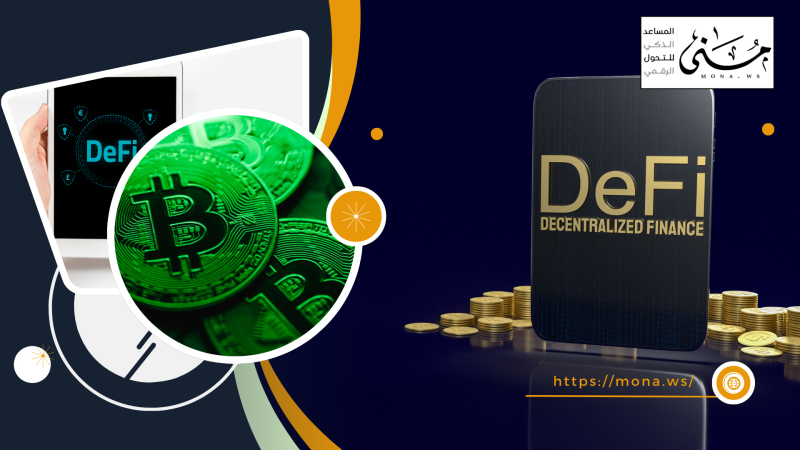Cryptocurrencies and Decentralized Finance (DeFi): Are We on the Verge of a Financial Revolution?
In recent years, the world has witnessed unprecedented developments in finance and business, with digital technologies playing a crucial role in reshaping the traditional financial system. Are we on the brink of a new economic revolution driven by cryptocurrencies and decentralized finance (DeFi)?
Cryptocurrencies such as Bitcoin and Ethereum are no longer just virtual assets; they have become a key part of discussions about the future of money. On the other hand, DeFi offers advanced financial solutions that go beyond the limitations of traditional banking, allowing users to lend, borrow, and trade freely without intermediaries. This transformation presents both challenges and opportunities, redefining the rules of the global economy and opening new horizons for investment and innovation.
Cryptocurrencies
What Are Cryptocurrencies?
Cryptocurrencies are a form of digital money traded electronically without the need for a physical intermediary like cash or coins. They rely on modern technology to manage transactions, making them more efficient and faster compared to traditional currencies.
Key Characteristics of Cryptocurrencies
Cryptocurrencies possess several features that distinguish them from traditional financial systems, including:
-
Fully Digital: They have no physical form and are stored and traded online.
-
Encrypted and Secure: They rely on cryptographic techniques to ensure transaction confidentiality and security.
-
Decentralized (in some cases): Many cryptocurrencies, such as Bitcoin, operate independently of any central authority, making them resistant to government control or financial interventions.
Types of Cryptocurrencies
Cryptocurrencies fall into several main categories based on their structure and usage:
1. Cryptocurrencies (Digital Currencies)
-
Rely on blockchain technology to secure and verify transactions.
-
Popular examples: Bitcoin (BTC) and Ethereum (ETH).
-
Operate without central control, giving users financial independence.
2. Central Bank Digital Currencies (CBDCs)
-
Issued by central banks as a digital alternative to national currencies.
-
Government-regulated, making them more stable than cryptocurrencies.
-
Examples: China’s Digital Yuan (e-CNY) and the upcoming Digital Euro.
3. Other Types of Digital Tokens
-
Utility Tokens: Used to access services or products within specific platforms (e.g., Binance Coin - BNB).
-
Governance Tokens: Allow holders to vote on the development decisions of decentralized projects (e.g., UNI in Uniswap).
Cryptocurrencies are not just a means of payment; they represent a significant evolution in finance, reshaping transaction and investment methods while unlocking new economic opportunities.
How Do Cryptocurrencies Work?
Cryptocurrencies rely on advanced technologies to ensure security, transparency, and decentralization. Key concepts include blockchain technology, consensus mechanisms like mining and proof of stake, and digital wallets.
Blockchain Technology: The Backbone of Cryptocurrencies
Blockchain is a distributed digital ledger that securely records all cryptocurrency transactions. It functions like a public ledger replicated across thousands of computers worldwide, making it difficult to alter or forge stored data.
How Blockchain Works
-
When a transaction (e.g., sending Bitcoin) occurs, it is recorded in a new data block.
-
A network of computers (nodes) verifies the transaction’s validity.
-
Once verified, the block is added to the existing chain, making the transaction permanent and immutable.
This structure makes blockchain decentralized, meaning no single authority controls it, and it operates across a distributed network of users.
Consensus Mechanisms: Mining and Proof of Stake
To ensure transaction validity and security, cryptocurrencies use different consensus mechanisms:
1. Mining (Proof of Work - PoW)
-
Used by cryptocurrencies like Bitcoin.
-
Requires miners to solve complex mathematical problems using computing power.
-
The first to solve the problem earns a cryptocurrency reward.
-
Downside: Consumes large amounts of energy.
2. Proof of Stake (PoS)
-
Used by Ethereum 2.0 and Cardano.
-
Instead of mining, validators are selected based on the amount of cryptocurrency they own and stake.
-
More energy-efficient and faster than Proof of Work.
Digital Wallets: Storing and Managing Cryptocurrencies
To store and transact cryptocurrencies, users need a digital wallet, which holds the private keys required for accessing their assets.
Types of Digital Wallets
-
Hot Wallets:
-
Connected to the internet (e.g., mobile apps, online platforms).
-
Easy to use but more vulnerable to hacking.
-
Examples: Trust Wallet, MetaMask.
-
-
Cold Wallets:
-
Offline storage (e.g., hardware devices, paper wallets).
-
More secure but less convenient.
-
Examples: Ledger, Trezor.
-
How to Send and Receive Cryptocurrencies
-
Users need a wallet address (similar to a bank account number).
-
When sending crypto, the user enters the recipient’s address and amount.
-
The blockchain network verifies the transaction before adding it to the ledger.
-
Once recorded, the transaction is final and irreversible.
Cryptocurrencies operate through a decentralized blockchain network, ensuring security and transparency. Consensus mechanisms like mining and staking validate transactions, while digital wallets provide a secure way to store assets. This system offers a strong alternative to traditional banks but requires a solid understanding to mitigate potential risks.
Decentralized Finance (DeFi): A Financial Revolution
What Is Decentralized Finance (DeFi)?
DeFi is a new financial system built on blockchain and smart contracts, enabling financial services without intermediaries like banks. It allows users to access lending, borrowing, trading, and payments transparently and securely without centralized control.
Goals of DeFi
DeFi aims to create an open, transparent, and decentralized financial system where individuals control their assets. This is achieved through:
-
Eliminating intermediaries: Transactions are executed via smart contracts, not banks.
-
Open access: Anyone with an internet connection can use DeFi services.
-
Transparency and security: All transactions are recorded on the blockchain, reducing fraud and ensuring accountability.
How Does DeFi Work?
DeFi’s Mechanism
DeFi operates through smart contracts on blockchain networks like Ethereum, automating financial transactions without intermediaries. These contracts enable various services such as lending, borrowing, and trading while ensuring users retain control over their assets.
Popular DeFi Applications
1. Lending and Borrowing
-
Platforms like Aave and Compound replace banks by allowing users to deposit crypto to earn interest or borrow against collateral.
2. Decentralized Exchanges (DEXs)
-
Platforms like Uniswap and SushiSwap enable direct crypto trading without intermediaries, using automated market makers (AMMs) for instant liquidity.
3. Yield Farming and Liquidity Provision
-
Users earn rewards by providing liquidity to DeFi platforms like Curve and Balancer through transaction fees and token incentives.
The Relationship Between Cryptocurrencies and DeFi
How DeFi Depends on Cryptocurrencies
DeFi is an extension of the cryptocurrency revolution, relying on digital assets as its foundation.
-
Lending platforms like Aave use cryptocurrencies as collateral.
-
DEXs like Uniswap facilitate crypto-to-crypto trading.
-
Many DeFi projects issue governance tokens for voting rights and incentives.
The Role of Stablecoins in DeFi
Stablecoins (e.g., USDT, USDC, DAI) play a crucial role in reducing volatility in DeFi applications.
-
Provide stability in lending and trading.
-
Enhance liquidity in DeFi platforms.
Integration of Blockchain Technology in Crypto and DeFi
-
Smart contracts execute transactions automatically.
-
Layer 2 solutions (e.g., Polygon) reduce transaction fees and enhance scalability.
-
Decentralized identity verification improves security and usability.
Conclusion
Cryptocurrencies and DeFi are transforming finance by enabling decentralized, transparent, and efficient financial systems. While the opportunities are immense, risks such as volatility, smart contract vulnerabilities, and regulatory uncertainty remain. As blockchain technology evolves, DeFi and cryptocurrencies are likely to play an even greater role in shaping the future of global finance.











Comments
Add New Comment